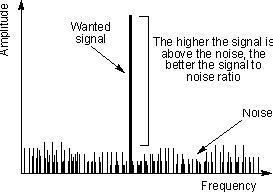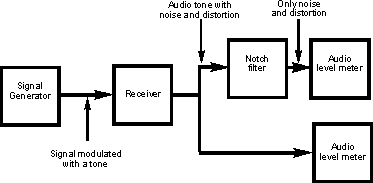Understanding Receiver Sensitivity
First published in Monitoring Times, October 2000
Receiver sensitivity is one of the key specifications of any radio. The two main requirements of any set are that it should be able to separate one station from another, i.e. selectivity, and signals should be amplified so that they can be brought to a sufficient level to be heard. As a result receiver designers battle with many elements to make sure that these requirements are fulfilled
Noise
Today technology is such that there is little problem in being able to achieve very large levels of amplification. This is not the limiting factor. In any receiving station the limiting factor is noise - weak signals are not limited by the actual signal level, but by the noise masks them out. This noise can come from a variety of sources. It can be picked up by the antenna or it can be generated within the receiver.
It is found that the level of noise that is picked up by a receiver falls as the frequency increases. At HF and frequencies below this the combination of galactic, atmospheric and man-made noise is relatively high and this means that there is little point in making a receiver superbly sensitive. Normally receivers are designed such that the internally generated noise is much lower than any received noise, even for the quietest locations.
At frequencies above 30 MHz the levels of noise start to reach a point where the receiver noise becomes far more important. By improving the noise performance of the set, it becomes possible to hear much weaker signals.
In terms of the receiver noise performance it is always the first stages or front end that is most crucial. At the front end the signal levels are at their lowest and even very small amounts of noise can be comparable with the incoming signal. At later stages in the set the signal will have been amplified and will be much larger. The same levels of noise as are present at the front end will be a much smaller proportion of the signal and will not have the same effect. Accordingly it is important that the noise performance of the font end is optimised for its noise performance.
Measuring noise performance
There are a number of ways in which the noise performance, and hence the sensitivity of a receiver can be measured. The most obvious method is to compare the signal and noise levels for a known signal level. Obviously the greater the difference between the signal and the unwanted noise, the better the sensitivity performance.

Figure 1 Signal to noise ratio
The difference is normally shown as a ratio between the signal and the noise (S/N) and it is normally expressed in decibels. As the signal input level obviously has an effect on this ratio, the input signal level must be given. This is usually expressed in microvolts. Typically a certain input level required to give a 10 dB signal to noise ratio is specified.
A number of other factors apart from the basic performance of the set can affect the specification. The first is the actual bandwidth of the receiver. As the noise spreads out over all frequencies it is found that the wider the bandwidth of the receiver, the greater the level of the noise. Accordingly the receiver bandwidth needs to be stated.
Additionally it is found that when using AM the level of modulation has an effect. The greater the level of modulation, the higher the audio output from the receiver. When measuring the noise performance the audio output from the receiver is measured and accordingly the modulation level of the AM has an effect. Usually a modulation level of 30% is chosen for this measurement.
This method of measuring the performance is most commonly used for HF communications receivers. Typically one might expect to see a figure in the region of 0.5 microvolts for a 10 dB S/N in a 3 kHz bandwidth for SSB or Morse. For AM a figure of 1.5 microvolts for a 10 dB S/N in a 6 kHz bandwidth at 30% modulation for AM might be seen.
SINAD
Whilst signal to noise specifications are often seen, another similar specification that is used is the SINAD measurement. This is most commonly used in conjunction with FM receivers, although there is no reason why it cannot be used for AM or even SSB. The measurement is similar to signal to noise ration, but includes distortion and is a ratio of signal plus noise plus distortion to noise plus distortion. To make the measurement a signal modulated with an audio tone is entered into the receiver. A measurement of the whole signal, i.e. the signal plus noise plus distortion is made. As the frequency of the tone is known and the regenerated audio is passed into a filter to remove the tone. The remaining noise and distortion is then measured.

Figure 2 Making a SINAD measurement
Normally the specification takes the form of a certain input level required to achieve a given SINAD. Typically a SINAD of 12dB is taken because this corresponds to distortion factor of 25%. A typical specification might be that a receiver has a sensitivity of 0.25 uV [microvolts] for a 12 dB SINAD. Obviously the lower the input voltage needed to achieve the given level of SINAD, the better the receiver performance.
Whilst the measurement is most commonly associated with FM equipment there is no reason why it cannot be used for AM, and in deed it often is. It can also be used for SSB, but it is necessary to ensure that the receiver is tuned into exactly the right frequency so that the audio tone is reconstituted with exactly the right pitch so that it can be properly notched out in the measurement.
To make the measurement a signal modulated with an audio tone is entered into the receiver. The frequency of the tone is known and the regenerated audio is passed into a filter to remove the tone. The remaining noise and distortion is then measured.
Noise Figure
For equipment that is used above 30 MHz a system known as Noise Figure is more widely used. However there is no reason why it cannot be used at any frequency and sometimes it is. The system is very versatile and can be used to measure the noise performance of a whole receiver, or a small part of a system like a preamplifier.
Essentially the measurement assesses the amount of noise each part of the system or the system as a whole introduces. If the system were perfect then no noise would be added to the signal when it passed through the system and the signal to noise ratio would be the same at the output as at the input. As we all know this is not the case and some noise is always added. This means that the signal to noise ratio at the output is worse than the signal to noise ratio at the input.
A figure known as the noise factor can be derived simply by taking the signal to noise ratio at the input and dividing it by the signal to noise ratio at the output:
As the signal to noise ratio at the output will always be worse, this means that the noise factor is always greater than one.
The noise factor is rarely seen in specifications. Instead the noise figure is always seen. This is simply the noise factor expressed in decibels.

Figure 3 Noise figure
In the diagram S1 is the signal at the input, N1 is the noise at the input
and S2 is the signal at the output and N2 the noise at the output
As an example if the signal to noise ratio at the input was 4:1, and it was 3:1 at the output then this would give a noise factor of 4/3 and a noise figure of 10 log (4/3) or 1.25 dB. Alternatively if the signal to noise ratios are expressed in decibels then it is quite easy to calculate the noise figure simply by subtracting one from another because two numbers are divided by subtracting their logarithms. In other words if the signal to noise ratio was 13 dB at the input and only 11 dB at the output then the circuit would have a noise figure of 13 - 11 or 2 dB.
Typical examples
The specifications of different pieces of equipment will vary quite widely. A typical HF receiver may have a noise figure of 15 dB of more and function quite satisfactorily. A better level of performance is not necessary because of the high level of atmospheric noise. However an amateur receiver used on Two metres, for example, might have a noise figure of 3 or 4 dB. Preamplifiers for this band often have a noise figure of around 1 dB. However it is interesting to note that even the best professional wide-band VHF UHF receivers may only have a noise figure of around 8 dB.
Summary
Receiver sensitivity is one of the vital specifications of any receiver. Whether measured as a signal to noise ratio, SINAD or noise figure it is essential that any receiver has a sufficient level of sensitivity. However this is not the complete story as other specifications are also important, as we shall see nest time when we look at dynamic range
© Ian Poole